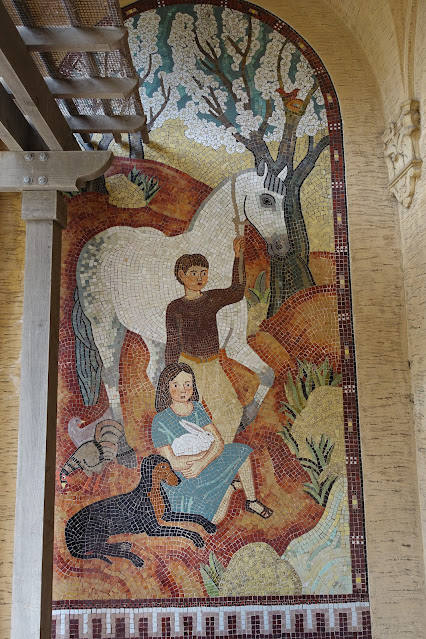Helen Bruton's zoo mosaics
 |
| Children and their Animal Friends San Francisco Zoo |
The sisters had never attempted large-scale mosaics before (each mosaic at the zoo measures thirteen feet high by six feet wide), but their inexperience was strangely freeing; as Helen pointed out, they were “almost more fortunate in having to start from scratch than in having a rigid technique from which to break away.”[1] The Brutons found much needed advice and guidance from their assistant, the Italian master mosaicist Antonio Falcier. Falcier was one of the Italian craftsmen who installed the mosaics in the Neptune Pool at Hearst Castle in San Simeon. As Helen said, “if it hadn’t been for Mr. Falcier, I don’t know what we would have done, because he gave us pointers that we would have been quite helpless without.”[2]
 |
| Children and their Animal Friends San Francisco Zoo |
 |
| Children and their Animal Friends San Francisco Zoo |
(detail) |
 |
| St. Francis San Francisco Zoo |
 |
| St. Francis San Francisco Zoo (detail) |
The installation process took about five days for each mosaic; during those two exhausting weeks, Falcier met the sisters at six o’clock every morning to help them carry the heavy mosaic sections onto the ferry and travel across the bay from Alameda to San Francisco. Helen was assigned a few male assistants to help with the installation. This was her first time supervising a staff, and she admitted that “it made me nervous because I wasn’t used to delegating work and… [I didn’t know] very much about mosaic myself.”[4]
 |
| St. Francis San Francisco Zoo (detail) |
Fortunately, Helen’s sisters were there for moral support, as was Falcier, who was on the job site every day, mixing the plaster, helping with the heavy lifting, and keeping the project on track. Once the plaster was placed on the wall, Falcier demonstrated how the sections of the mosaic were placed from the bottom and worked up; it was essential that “the section that you were mounting was square enough in shape so that it didn’t sag or settle too badly at one side or another, and begin to throw the thing out of whack… it was a little like a jigsaw puzzle on a big scale.”[5] Once each section was set in the plaster, the paper attached to the face was peeled off, and the surface of the mosaic was washed and polished. Helen estimated the entire project was completed by June 1934, in a surprisingly quick three months. In her words, “it knocked off a couple of years off my life getting it up there on the wall.”[6] Both mosaics at the San Francisco Zoo are signed “Bruton 1934”. Given the extensive assistance she received from her sisters, perhaps Helen thought using the family name as a signature was only fair.
The decision to create the Mothers House murals in mosaic was wise and fortuitous; mosaics are incredibly durable, even when exposed to the elements. When Helen went back to view the murals in the mid-1960s, she was pleased to discover that they were “exactly the same as they were… I can’t see that there’s been any deterioration at all.”[7] Even today, the mosaics at the Mother’s House remain in excellent condition.
I wish you could see Helen Bruton's mosaics as soon as the Zoo reopens; unfortunately, the Mothers House building is closed due to seismic concerns, and the mosaics can't be seen by the public. (Special thanks to the Zoo staff who made special arrangements for me to photograph the works.) Right now, the Zoo's main concern is feeding and caring for the animals during this economic crisis. You can help by donating here.
All photographs by the author.
[1] Helen Bruton, “Mosaic as a modern expression,” San Francisco Art Association Bulletin, Dec. 1936, p. 4.
[2] Helen and Margaret Bruton, interview, Dec. 4, 1964.
[3] A decade later, the sisters described a slightly different method; they would “take a piece of light cloth, cover it with wallpaper paste and smooth the cloth over the top of the mosaic.” (Sunset Magazine, Oct. 1947)
[4] Helen and Margaret Bruton, interview, Dec. 4, 1964.
[5] Helen and Margaret Bruton, interview, Dec. 4, 1964.
[6] Helen and Margaret Bruton, interview, Feb. 26, 1976, Video 1, 24:32-24:36.
[7] Helen and Margaret Bruton, interview, Dec. 4, 1964.




Comments
Post a Comment